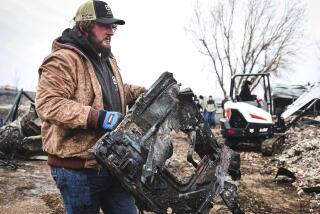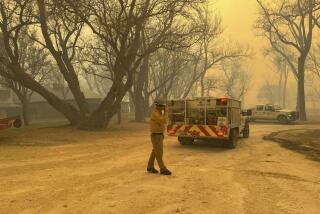Remote Alaska town threatened by lightning-sparked blaze; wildfires rage in West
Firefighters in Alaska worked to save the tiny town of Nulato on Tuesday as a lightning-sparked wildfire spread, forcing about 50 of 200 residents to evacuate.
The fire had covered more than 800 acres by Tuesday afternoon, officials said. Although much larger wildfires have plagued the state recently, a spokesman for the Joint Information Center in Fairbanks said the Nulato fire was the highest priority because it threatened the village, which is near the Yukon River.
“The village town is very important to all the fire community here,” said Timothy Evans, an information officer from the Interagency Coordination Center in Alaska. “These folks can’t just get into a car and leave.”
Nulato is accessible only by boat.
Since the beginning of the year, fires have scorched hundreds of square miles across Alaska. In all, 226 lightning-caused fires have burned nearly 300,000 acres. In the southwestern part of the state, a lightning-sparked blaze refueled by omnipresent black spruce trees has burned nearly 12,000 acres. Another one, the Tozitna fire, has consumed 12,500 acres.
“Lightning doesn’t care if it’s in the city or the tundra,” Evans said in a phone interview.
Wildfires are part of Alaska’s environmental cycle, but persistent hot and dry weather, partly due to lower accumulations of snowfall, has exhausted fire resources in the state.
On Tuesday evening, other states also were struggling to suppress wildfires. Near Cave Junction, Ore., more than 500 firefighters battled a blaze that was caused by lightning on June 11. That fire has burned nearly 5,000 acres, but it was not expected to spread further.
“We have a line all the way around it,” said Joe Anderson, a fire information officer in Oregon.
Anderson attributed the Oregon fire situation to high temperatures abnormal for this time of the year and a lesser snowpack in this second year of a slight drought. The high is expected to reach 106 by Friday.
“This is very unusual for Oregon,” Anderson said.
And in Washington state, a crew of 67 was battling a blaze in a remote area of Olympic National Park, where smaller fires are normally allowed to burn. Crews decided to control this one because of the drier conditions.
“Winter was normal in terms of precipitation, but way below precipitation averages in the mid-elevation range,” said John Papineau, a ranger in the Quinault area of the the national forest.
Twitter: @natalieschachar
More to Read
Start your day right
Sign up for Essential California for news, features and recommendations from the L.A. Times and beyond in your inbox six days a week.
You may occasionally receive promotional content from the Los Angeles Times.






